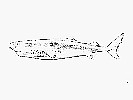Somniosus pacificus
Bigelow & Schroeder, 1944
Pacific sleeper shark
Classification: Elasmobranchii Squaliformes Somniosidae
Reference of the original description
New sharks from the Western North Atlantic. Proceedings of the New England Zoölogical Club, 23, 21–36
New sharks from the Western North Atlantic. Proceedings of the New England Zoölogical Club, 23, 21–36
Synonyms / new combinations and misspellings
Somniosus cf. pacificus, Somniosus (Somniosus) pacificus
Somniosus cf. pacificus, Somniosus (Somniosus) pacificus
Description :
Citation: Somniosus pacificus Bigelow & Schroeder, 1944: In: Database of modern sharks, rays and chimaeras, www.shark-references.com, World Wide Web electronic publication, Version 05/2025
Please send your images of "Somniosus pacificus" to info@shark-references.com

Somniosus pacificus Bigelow & Schroeder, 1944, TL 286 mm, coll.: Pacific Shark Research Center, MLML; © Digital Fish Library

Somniosus pacificus Bigelow & Schroeder, 1944, TL 286 mm, coll.: Pacific Shark Research Center, MLML; © Digital Fish Library
Common names
 Tiburón dormilón del Pacifico,
Tiburón dormilón del Pacifico,  Tollo dormilón,
Tollo dormilón,  Tollo negro dormilón,
Tollo negro dormilón,  Laimargue dormeur,
Laimargue dormeur,  Pacific sleeper shark,
Pacific sleeper shark,  Sleeper shark,
Sleeper shark,  Southern sleeper shark
Southern sleeper shark
 Tiburón dormilón del Pacifico,
Tiburón dormilón del Pacifico,  Tollo dormilón,
Tollo dormilón,  Tollo negro dormilón,
Tollo negro dormilón,  Laimargue dormeur,
Laimargue dormeur,  Pacific sleeper shark,
Pacific sleeper shark,  Sleeper shark,
Sleeper shark,  Southern sleeper shark
Southern sleeper shark
Short Description
Uniformly greyish-pink with bluish black fins; live specimens probably with white spots on dorsal surface [1388]. Short rounded snout, heavily cylindrical body and small precaudal fins, equal-sized dorsal fins, asymmetrical caudal fin with a well-developed ventral lobe [1388], first dorsal fin on back closer to pelvic fins than pectoral fins, interdorsal space less than distance from snout tip to first gill openings, no short keels on base of caudal fin, upper teeth lanceolate, lower teeth with short, low, strongly oblique cusps and high narrow roots [518]. Diet: Gulf of Alaska (data base: 13 stomachs were analyzed): Arrowtooth flounder, Atheresthes stomias, was the most important prey, representing 67% of the total stomach content weight (64% of frequency of occurrence). Other prey included a 48-cm walleye pollock, Theragra chalcogramma (5.2% by weight), a single 33-cm rockfish, Sebastes sp., a 40-cm Pacific salmon, Oncorhynchus sp., and a 26-cm flathead sole, Hippoglossoides elassodon, as well as three unidentifiable flatfish. Octopus dofleini were the most important invertebrate found in the diet of sleeper sharks, representing 5% of the total stomach contents weight and 73% of the frequency of occurrence. Less important invertebrate prey included squids, snails (Fusitriton sp.), hermit crabs, and gammarid amphipods. [16996].
Uniformly greyish-pink with bluish black fins; live specimens probably with white spots on dorsal surface [1388]. Short rounded snout, heavily cylindrical body and small precaudal fins, equal-sized dorsal fins, asymmetrical caudal fin with a well-developed ventral lobe [1388], first dorsal fin on back closer to pelvic fins than pectoral fins, interdorsal space less than distance from snout tip to first gill openings, no short keels on base of caudal fin, upper teeth lanceolate, lower teeth with short, low, strongly oblique cusps and high narrow roots [518]. Diet: Gulf of Alaska (data base: 13 stomachs were analyzed): Arrowtooth flounder, Atheresthes stomias, was the most important prey, representing 67% of the total stomach content weight (64% of frequency of occurrence). Other prey included a 48-cm walleye pollock, Theragra chalcogramma (5.2% by weight), a single 33-cm rockfish, Sebastes sp., a 40-cm Pacific salmon, Oncorhynchus sp., and a 26-cm flathead sole, Hippoglossoides elassodon, as well as three unidentifiable flatfish. Octopus dofleini were the most important invertebrate found in the diet of sleeper sharks, representing 5% of the total stomach contents weight and 73% of the frequency of occurrence. Less important invertebrate prey included squids, snails (Fusitriton sp.), hermit crabs, and gammarid amphipods. [16996].
Distribution
North Pacific: Japan and along the Siberian coast to the Bering Sea, southern California (USA), and Baja California, Mexico. Sporadic records from the South Pacific (assignment of large southern hemisphere Somniosus to the North Pacific Somniosus pacificus is tentative) [544]. In Australasian waters, it occurs from the seamounts south of Tasmania, the Challenger Plateau (off eastern New Zealand) and possibly from Macquarie Island [1388]. Southwest Atlantic: off Uruguay [3717], Brazil (Ref. 53443) and Argentina [5839]. Source: www.gbif.org
North Pacific: Japan and along the Siberian coast to the Bering Sea, southern California (USA), and Baja California, Mexico. Sporadic records from the South Pacific (assignment of large southern hemisphere Somniosus to the North Pacific Somniosus pacificus is tentative) [544]. In Australasian waters, it occurs from the seamounts south of Tasmania, the Challenger Plateau (off eastern New Zealand) and possibly from Macquarie Island [1388]. Southwest Atlantic: off Uruguay [3717], Brazil (Ref. 53443) and Argentina [5839]. Source: www.gbif.org
Human uses
fisheries: of no interest
fisheries: of no interest
Biology
Probably ovoviviparous [518]. Size at birth 42 cm or less [578]. Distinct pairing with embrace [17086]. Found on the continental slope (Ref. 75154).
Probably ovoviviparous [518]. Size at birth 42 cm or less [578]. Distinct pairing with embrace [17086]. Found on the continental slope (Ref. 75154).
Remarks
shark-references Species-ID=6498;
shark-references Species-ID=6498;
Parasites (arranged by Jürgen Pollerspöck)
Monogenea
Cestoda
Nematoda
Copepoda
Monogenea
- Erpocotyle somniosi (Causey, 1926) Price, 1942 [17919]
Cestoda
- Hepatoxylon trichiuri (Holten, 1802) [16112] [25154]
- Monorygma perfectum (Van Beneden, 1853) [17919]
- Monorygma sp. [28988]
Nematoda
- Anisakis sp. [21430]
Copepoda
- Dinemoura ferox (Krøyer, 1838) [7601] [7597] [21430]
- Ommatokoita elongata (Grant, 1827) [7596] [17919]
















